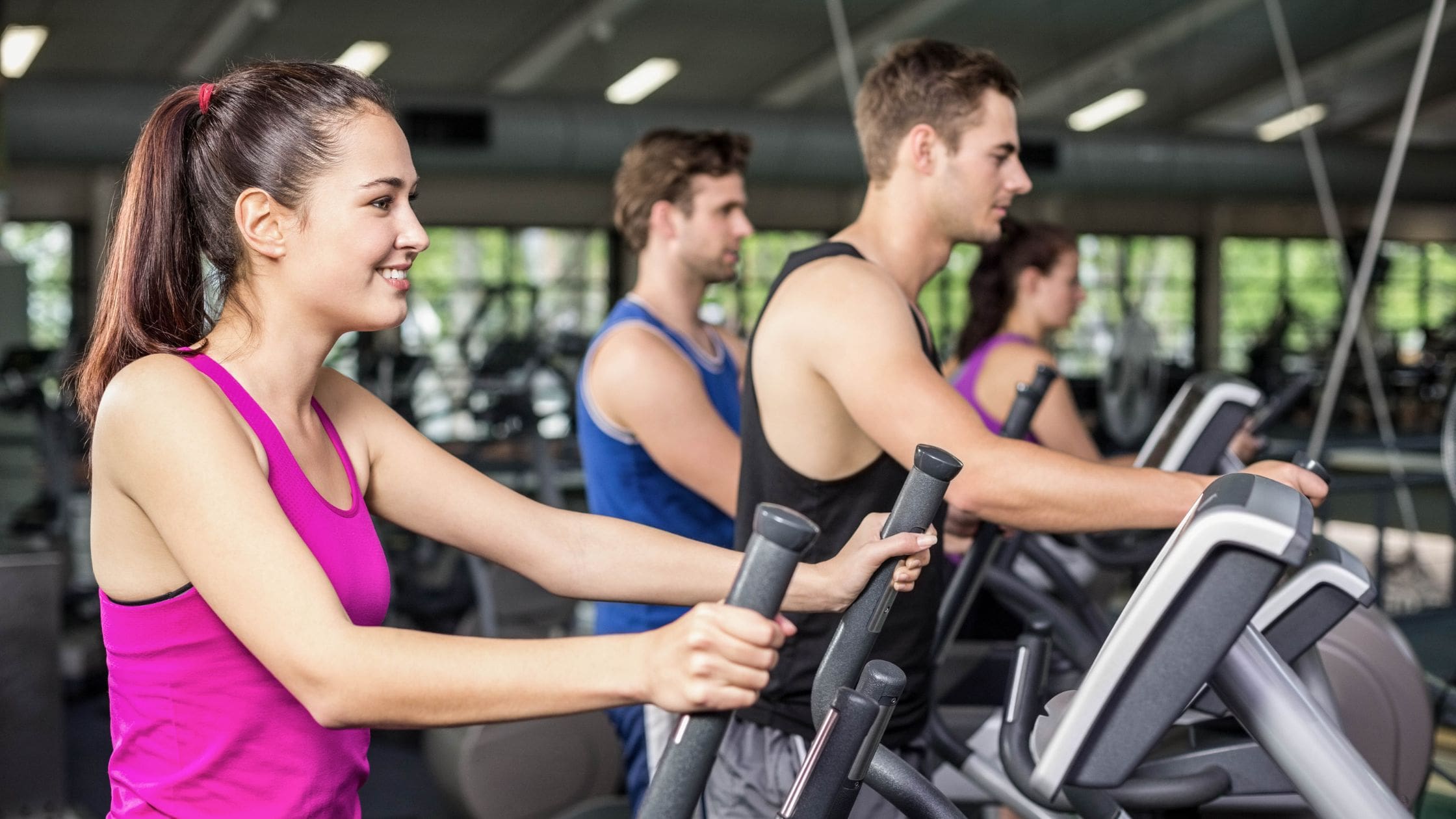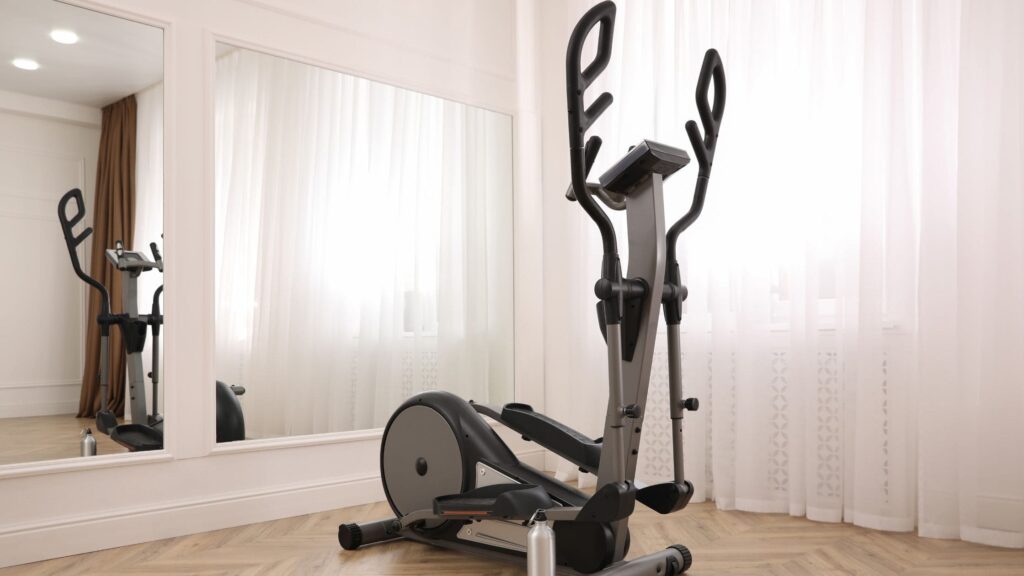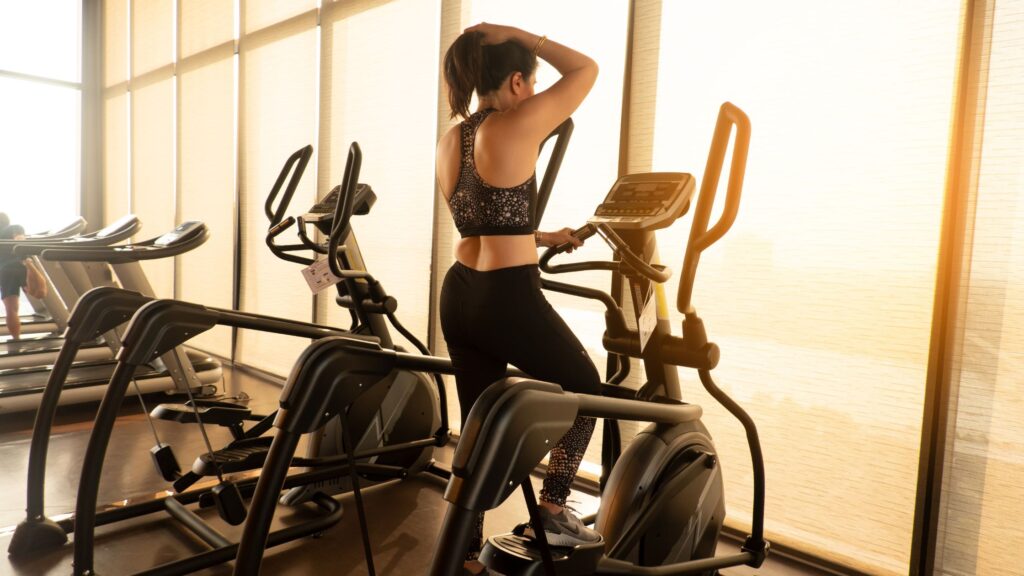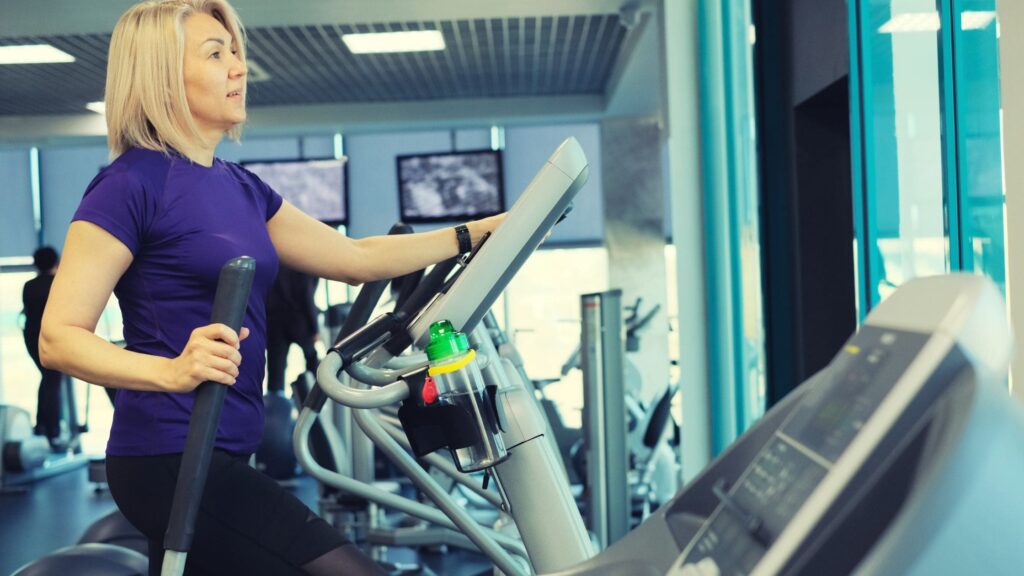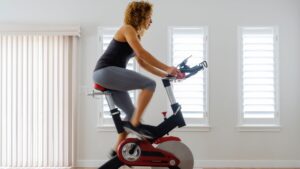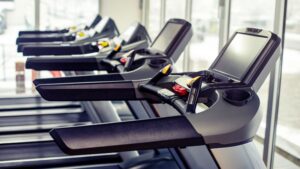An elliptical machine or elliptical trainer is a piece of exercise equipment designed to imitate running but with less impact on your joints. You can also use this type of exercise equipment to simulate climbing, cycling, and walking. You’ll commonly find them in your local gym, fitness center, and health club, but you can also purchase elliptical machines to use at home.
An elliptical is a fun way to exercise and burn calories with minimal risk of getting injured.
In this guide, you’ll find all the information you need to make an informed decision when it comes to purchasing an elliptical for your workout routine at home.
What is an Elliptical Trainer?
An elliptical trainer, also known as a cross-trainer, X-trainer, or elliptical machine, is a stationery type of cardio machine.
It provides a low-impact cardio exercise and is of great benefit to your overall fitness. It also helps to increase your stamina and strengthens your upper and lower body.
You use an elliptical to stair climb, run, walk, or cycle without causing excessive pressure on the joints.
Elliptical trainers are popular for people with certain injuries because they allow them to stay fit but with minimal adverse effects.
You can use elliptical trainers for a non-impact cardiovascular exercise varying from light to high intensity. The intensity can be changed depending on the speed of the exercise and the user’s preferences.
History of Elliptical Trainers
Elliptical trainers first appeared in the fitness scene around the 1990s. The first machines were designed merely for a lower body workout. It wasn’t until 1997 that the first elliptical appeared that was for exercising the upper and lower body.
This first true elliptical was manufactured in the US by a company called Smooth Fitness.
The first elliptical patent came from a General Motors employee in 2004. His name was Larry D. Miller and his inspiration came from filming his daughter running alongside his car. He noticed that her movements were in the shape of an ellipse. Miller’s patent was purchased by Precor Inc. and the company developed the machine and added it to its EFX line of exercise equipment.
Nowadays, there are more than 100 different elliptical trainer models available to purchase in the United States.
What is the Difference Between an Elliptical and a Cross Trainer?
A cross trainer is different from an elliptical trainer because it has arms that move. The incline of the leg pedals is also not adjustable.
The moving arms of a cross trainer allow you to tone your upper body because you can push and pull your arms while pedaling.
A cross trainer uses muscles in the upper body that an elliptical trainer does not, such as the back, shoulder, chest, forearm, and upper arm muscles.
A cross trainer is more challenging to use because it requires more balance and coordination than an elliptical trainer.
People with disabilities or older people may find an elliptical trainer easier to use because it has handlebars that don’t move.
How Does an Elliptical Machine Work?
The machine contains articulating foot pedals or plates. These movable and adjustable plates produce the natural elliptical motion on the machine. Your feet stay in constant contact with the plates as they adjust to the elliptical motion’s angle. The foot pedals drive the machine’s motion.
With your feet planted on the two footholds, there is less impact and it’s more of a gliding motion.
Some ellipticals have hand bars, which can help provide more of a full-body elliptical workout. There is also the option of pedaling in reverse so you can challenge different muscle groups.
What are the Key Components of an Elliptical Trainer?
While there are various types of elliptical trainers, their basic components are essentially very similar. If you want to buy one for your personal use, you should understand the major parts that make up an elliptical trainer.
- Drive System: Front vs. Rear Drive: The flywheel that drives an elliptical trainer can be either in front or behind the user. If the flywheel is behind, it’s considered more bio-mechanically correct because the user has to pull it to make it work.
- Elliptical Frame Construction: The frame is the skeleton of an elliptical which makes it important. How the machine is constructed has a big impact on how it feels when you’re using it. You create a lot of energy when you use an elliptical so you want a frame that can absorb it. When doing your research, check whether bolts or welds are used, the type of steel used, and the overall weight of the machine.
- Stride Length: The stride length is determined by several things such as the placement of the flywheel and the length of the rails. A good range is between 18 and 22 inches, depending on your height. Shorter stride lengths can feel constrained while longer stride lengths can feel unnatural.
- Resistance System: A wide range of resistance levels are often included. You can adjust the resistance level using a manual control or electronically via a control panel. The more resistance levels there are, the better you can control your elliptical machine workout intensity.
- Electronic Options: When it comes to electronic options, the more bells and whistles your elliptical trainer has is a personal thing. Some of the options you might look for include entertainment options, heart rate control, and feedback, several types of workout programs, memory features such as user profiles, elliptical workout calendars, fitness apps metric feedback, USB or Bluetooth connectivity, touchscreens, speakers, cross training options, and personalized coaching.
- Stationary or Moveable Arms: Most elliptical trainers have moveable arms. These will be interconnected to the peals and resistance system. Fixed or stationary arms tend to be less common nowadays. This type of elliptical equipment is primarily for lower-body elliptical workouts and for people who prefer not to use their arms regularly.
- Linkages: The integrity of an elliptical consists of linkages. These are where two pieces of metal join. Cheaper machines use bushings that pivot on each other. These can wear over time and lead to increased noise and friction. Bearings are a better linkage system because they are much smoother and require less maintenance. Rather than two flat pieces of metal, bearings are rounded and reduce the coefficient of friction, creating less heat, wear, and noise.
- Suspension Systems: Elliptical manufacturers use wheels directly connected to the pedals or suspension systems. With suspension ellipticals, the pedals have independent pivot points connected directly to linkages. These are directly connected to the flywheel. In effect, you are “suspended” in the air when you’re using the machine, hence the name suspension systems. They are designed this way to reduce the amount of maintenance. A suspension system is also much quieter than a wheel-on-ramp system.
What is an Elliptical Trainer Good For and Why Do You Need One?
Elliptical trainers can help you stay healthy and physically fit and lose weight. With an elliptical machine, you’re able to get a good aerobic workout. This can strengthen not only your muscles but your heart and lungs as well.
In turn, this also helps improve your endurance and stamina. Other options with elliptical equipment is steady-state cardio workouts and high-intensity interval training.
What are the Different Types of Elliptical Machines Out There?
Elliptical trainers come in a variety of different sizes, with a range of different features. Each has its unique features and benefits. Understanding what these are will make choosing the best one easier. Here are some of the most common types:
Front-Drive Elliptical Machine
This type of exercise machine has a flywheel at the front. It delivers a more vertical range in motion, making it similar to a stair climber. You’ll also see it referred to as a shuffle trainer. Choose front-drive elliptical gym equipment if you want an option that’s close to the ground.
Rear-Drive Elliptical Machine
This is the oldest type available and is the machine patented by Precor in the 90s. The flywheel is at the back of the machine which allows for longer strides in the front and pedals in the center.
Which is Better? A Front or Rear Drive Elliptical Machine?
Front-drive elliptical trainers are a popular choice for many home gyms because they offer flexible elliptical exercise options and tend to be more available.
Rear-drive elliptical trainers, on the other hand, are often quieter and require less maintenance, but take up more space and tend to be more expensive. They are most often found at commercial gyms.
Center-Drive Elliptical Machine
There are elliptical cardio machines that have the flywheel in the center. They are one of the latest innovations and are a great option for the home because they’re compact.
Hybrid Elliptical Machine
A hybrid elliptical machine typically combines an elliptical trainer with another type of traditional cardio exercise equipment. For example, it might include a bike component or a stair-climbing motion.
Compact Elliptical Machine
Compact elliptical machines are just pedals mounted onto a small flywheel. The machine is small enough to slide under a desk to pedal while you’re working.
There are compact elliptical cardio machines you can use while standing, but most are designed to use while sitting.
Adjustable Stride Elliptical Machine
An adjustable stride elliptical machine allows you to change how far apart the pedals are moving during your workouts. Adjustments can be made by pushing a button or manually changing the length of the pedal supports.
With adjustable stride elliptical machines you get a larger range when it comes to stride length.
Folding Elliptical Machine
A folding elliptical machine is slightly bigger than a compact elliptical machine. It has pedals, a flywheel, and handles but folds down small enough to be stored out of the way when not in use.
Under-Desk Elliptical Machine
Under-desk elliptical cardio machines are great if you want to get more steps in during the day without leaving your desk. These machines are small and you can place them on the floor under your desk.
Cross-Training Elliptical Machine
You should consider a cross-training elliptical machine if you want a full-body workout. Elliptical cross-trainers work your entire body thanks to the moveable handles that work your arms.
When you push or pull with the handles of cross-training elliptical machines, the target is your elbows, shoulders, back, and chest. At the same time, you’re also working your lower body.
Which Type of Elliptical Machine Is Best?
Deciding which is the best elliptical is a very personal thing and depends on your preferences, available space, budget, and personal fitness goals.
It’s always a good idea to test various models and features if possible. This allows you to find a machine that’s comfortable and meets your needs.
What are the Advantages and Disadvantages of an Elliptical Machine?
There are many different brands of ellipticals and a variety of styles. Each machine provides slightly different benefits, but in general, they can be categorized as follows:
Advantages
The advantages of using an elliptical machine include the following:
- Low-impact cardio workout: Reduces the stress and strain on your leg muscles.
- Full-body workout: When you use an elliptical correctly, you’re engaging your biceps, triceps, back, chest, glutes, hamstrings, and quadriceps.
- Cardiovascular health benefits: Use an elliptical trainer for 20-30 minutes every day and it will increase your heart rate and strengthen your muscles.
- Versatility: Elliptical trainers are equipped with a range of challenging exercise programs.
- Calorie burning and weight loss: Use an elliptical trainer for 30 minutes and you could burn between 150 and 400 calories depending on the speed and your current weight.
- Low maintenance: An elliptical machine has fewer moving parts, and uses a low-impact elliptical motion making it less likely to require service.
- Low risk of injury: Your feet never leave the pedals, so your body is not subjected to repeated impact. It’s also less stressful and safer for your joints.
- Convenience: It doesn’t take long to learn how to use one.
- Accessible: You can purchase an elliptical trainer to use in the home or at the office.
- Variety of elliptical machine workouts: This makes training more fun and interesting.
- Easy to use: All you need to do is step on the pedals, grab hold of the handles, and then walk or run.
Disadvantages
The disadvantages of using an elliptical trainer are outweighed by the advantage, but are still worth pointing out:
- Expensive: Unless you have a large budget, owning an elliptical might not be the best option.
- Limited upper body workout: Ellipticals are not great for building strength and muscle, particularly in your upper body and arms.
- Limited variety: You might choose an elliptical with incline settings, but apart from that, the range of motion and basic movement never changes.
- Not suitable for everyone: While it’s a safe option to use if you’re recovering from an injury, it may trigger more pain in your knees.
- Non-weight-bearing: An elliptical trainer won’t help you gain muscular strength because it’s non-weight bearing.
- Risk of overuse injuries: The most common overuse injury on an elliptical involves the knee.
- Boredom: Cardio and elliptical machine workouts in general can get very monotonous.
- Unnatural movement: The elliptical range of motion doesn’t reflect anything our bodies like to do naturally.
Who Should Use an Elliptical Trainer?
Elliptical machines are designed for aerobic exercise and cardiovascular workouts. They are commonly used to increase a person’s heart rate, burn calories, and lose body fat.
Who Should Not Use an Elliptical Trainer?
You shouldn’t use an elliptical trainer if you’re at risk of thinning bones or osteoporosis. This is because you don’t get the benefit of your feet hitting the ground which you would get when running. That type of impact boosts your bone density.
Elliptical exercise is also not recommended if you’re recovering from a knee injury as it may exacerbate the injury.
Does an Elliptical Trainer Require Maintenance?
Yes, an elliptical trainer does require maintenance but not as much as other types of exercise equipment.
For example, you should perform regular inspections to ensure nothing is loose, broken, or damaged. You should also clean your machine with a soft cloth and warm water. Lubrication may also be required.
How Long Do Elliptical Trainers Last?
When properly maintained, a good-quality elliptical should last for a minimum of 10 years. A high-end model may last longer.
>How Much Does an Elliptical Trainer Cost on Average?
A no-frills elliptical trainer will set you back around $300. For a sturdier, commercial-grade elliptical you can expect to pay between $1,000 and $2,500. For a commercial trainer, the cost will be $5,000 or more.
How To Choose The Right Elliptical Machine for You?
It’s not always easy to choose the right exercise machine for you, but knowing what factors to consider will help. Consider the following:
- Space: Elliptical machines range in size but are about 6 feet long by 2.5 feet wide on average.
- Features: Features can be a great bonus, but only if you use them.
- Durability: Buying elliptical exercise equipment is a big investment so choose the most durable your budget will allow.
- Brand Reputation: It’s always better value if you choose to purchase an elliptical machine from a well-known brand.
- Personal fitness goals: If your goal is to develop your endurance and performance, invest in a model with more features that’s been designed for intensive use.
- Heart Rate Monitoring: This is important if you want to train more accurately on heart rate.
- Noise: Rear-drive elliptical trainers tend to be quieter.
- Maintenance Assembly: Elliptical machines require minimal maintenance but it is nevertheless required if you want your machine to last as long as possible.
- User Weight Capacity: Pay close attention to the maximum user weight associated with the safe use of an elliptical trainer.
- Ergonomics: Try before you buy and see how comfortable an elliptical feels.
- Exercise Intensity: Elliptical machines come with variable
- Connectivity: Bluetooth connectivity will allow you to connect your phone or tablet wirelessly.
- Programs: If an elliptical machine has exercise programs it will make your elliptical machine workout more varied and less monotonous.
- Safety Features: Elliptical machines are dangerous, particularly for children. Employ any available safety features.
Where to Buy an Elliptical Trainer?
Elliptical trainers can be purchased from a variety of fitness stores both online and brick-and-mortar establishments. However, don’t forget to look at what’s available at bestusedgymequipment.com. These leaders in selling used gym equipment have an excellent range available to suit all budgets and tastes.
What are Some Alternatives to Elliptical Trainers?
Treadmills are one great alternative to elliptical trainers. It provides a similar workout by simulating walking, jogging, or running. Treadmills mimic natural movements and improve bone density but may strain joints. On the other hand, ellipticals provide low-impact, full-body workouts. Always consider factors like fitness goals, joint health, space, noise levels, and budget when choosing between elliptical trainers and treadmills.
Here are few other alternatives to ellipticals:
- Stationary bikes: Stationary bikes, also known as exercise bikes, offer a low-impact cardiovascular workout. They come in two main varieties: upright and recumbent. Upright bikes simulate the feeling of riding a traditional bike, while recumbent bikes have a more comfortable seat and a backrest.
- Rowing machines: Rowing machines offer a full-body workout that targets multiple muscle groups. They simulate the motion of rowing a boat, and can be adjusted for different levels of resistance.
- Steppers: Steppers simulate the motion of climbing stairs, offering a low-impact workout that targets the legs and glutes. They come in two main varieties: stair steppers and pedal steppers.
- Cross-country ski machines: Cross-country ski machines simulate the motion of skiing, providing a low-impact full-body workout. They offer adjustable resistance levels and can be used indoors year-round.
- Jump ropes: Jumping rope provides a high-intensity cardiovascular workout that can be done anywhere. It’s a low-cost alternative to elliptical trainers that requires only a rope and some space.
Conclusion
The elliptical machine has revolutionized the way we approach cardiovascular exercise by providing a low-impact, full-body workout that is accessible to a wide range of individuals. With its diverse range of styles and features, there’s a type to suit everyone’s preferences and fitness goals.
While there are a few disadvantages to consider, the many benefits of incorporating an elliptical trainer into your fitness routine far outweigh these drawbacks. As you explore the world of elliptical machines, take the time to test various models and features to find the perfect fit for your needs.
Ultimately, an elliptical machine can be a valuable addition to your home or commercial gym, providing a fun and effective way to maintain your health and achieve your fitness and business goals.


